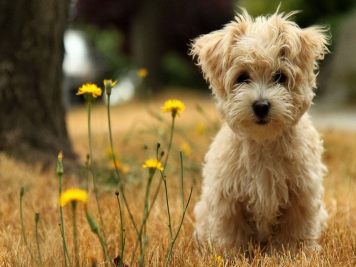 While we enjoy the outdoor ambiance in our yards, we sometimes lose track of the fact that plants we love can be downright toxic to dogs and cats.
While we enjoy the outdoor ambiance in our yards, we sometimes lose track of the fact that plants we love can be downright toxic to dogs and cats.
A few plant adjustments and other pet-friendly accommodations can make the difference between an unsafe environment and a pet-friendly one. Know which plants are toxic. Many dogs eat grass and nibble or gnaw on other plants, so it’s good to know which plants are toxic or harmful.
- Wild mushrooms often grow in the early summer or during wet summers in moist places in the lawn, on tree trunks and on firewood. Don’t rake or mow them as that spreads spores to grow more ‘shrooms. Wear a glove or a baggie over your hand, pick mushrooms up and put them in the trash. No, they are NOT for the compost bin.
- Weeds. Since some weeds like purslane are toxic to pets, there’s another good reason to keep your yard weed free.
- Foxglove digitalis. Pretty as this flowering plant is, it can cause heart failure.
- Lilies cause GI upset and day lilies can cause renal failure in cats.
- Bulbs. Most spring-blooming bulbs such as tulips and daffodils are toxic if the dog digs them and chews them up. It’s the same for the rhizomes of iris plants.
- Tall ornamental grasses. If dogs ingest these plants, the sharp grass blades can cut their stomachs and create serious medical issues.
- Toxic fruits and veggies include: plants in the onion family, rhubarb, chamomile, grapes (including raisins) and the seeds of stone fruits.
Pay attention to your pet’s habits and if he likes to gnaw on plants, select non-toxic varieties. Here are more tips for creating a pet friendly yard:
- Don’t deck the dog. Unless your deck is well shaded, put the dog under it rather than on it. Wood decks often have splinters and dark woods absorb so much heat on hot days that they can create conditions leading to heat stroke. If you are building a deck, look for lighter shades of recycled products that are cooler and splinter free. They are often more human-friendly, too, by requiring less ongoing maintenance than wood.
- Compost with an enclosed tumbler. The smell of an open compost bin or tumbler will attract animals, including your pet. Eating decaying compost can make your pet sick, so avoid the risk by using an enclosed tumbler.
- Create shade to keep your pet cool. If there are no shade trees, make sure the dog has access to a covered porch or patio on the north and east sides of the house. A dog will also duck into the shade of the trampoline or other structures if you make the area accessible.
Watch out for nesting females. Female dogs like to dig nests in the cool spaces next to foundations. In wet weather, these holes fill with water, make muddy paws and can lead to foundation problems. Creating cool spaces away from foundations can head off these issues.
Contact Designscapes Colorado, info@designscapes.org for more information.
